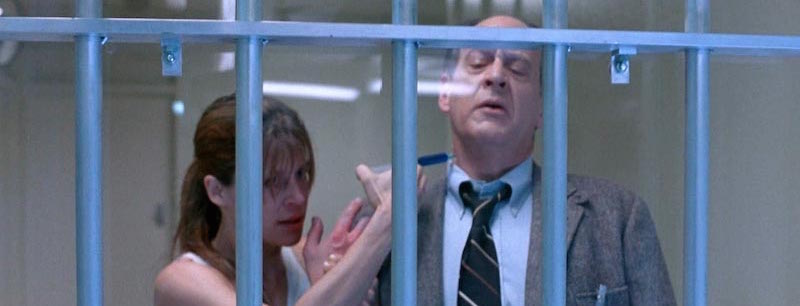I don’t care who you are, where you’re from, or how jaded you’ve grown over the years: “time-traveling cyborg” is a great pitch.
It’s crazy, sure, but craziness is the point of the Terminator films. Zapping the limitless insanity of the future into the ordinary present day is a profoundly satisfying fusion, not unlike the Terminator’s trademark melding of man and machine. (The 2009 trainwreck Terminator: Salvation disregarded this all-important pairing of the fantastical with the familiar; for that and many other reasons it is unwatchable and wholly omitted from this article.) The gears of the venerable franchise have always turned on the threshold between the exhilaratingly ridiculous and the genuinely frightening. Mind-twisting time travel logic and buff androids wearing sunglasses and leather jackets are juxtaposed with not-too-distant-future paranoia regarding artificial intelligence.

In the films’ mythos, the end of the world is brought about when a sentient computer network known as SkyNet decides that human beings are a threat to its existence, and so proceeds to instigate a nuclear war to eradicate our species. But it is difficult to argue that the films are chiefly about the dangers of technology, as all of the machines’ greatest transgressions occur after the movies are set. The post-apocalyptic wasteland of Los Angeles 2029 is a terrifying promise, one glimpsed chiefly through dream sequences and expository dialogue from time travelers. Not only that, we are repeatedly fed the mantra that there is no such thing as fate, and what lies ahead may be one of many possible futures.
All the action takes place in the present day, where the only threat facing the Connors and their allies is a lone Terminator (first Arnold Schwarzenegger’s CSM-101, then Robert Patrick’s T-1000, and finally Kristanna Loken’s T-X). And while Terminators are indefatigable, they are uncomplicated. SkyNet may be self-aware but Terminators are little more than programmable kill-bots; “find and kill” is their sole prerogative. What makes them compelling (and deadly) is not their metal skeletons that can weather a hail of gunfire and punch through walls, but their fleshy exteriors. Terminators look like people, and so people don’t believe that they are Terminators. “Time-traveling cyborg” is, after all, a ludicrous premise.
The disbelief of others is the true antagonist of the Terminator films. Rather than ponder the vicissitudes of artificial intelligence, the franchise spends far more time asking the existentially disturbing question, “What if you were right, but everyone thought you were crazy?” It is fitting, therefore, that the only character who appears in all three films (including Arnold, as he plays a different CSM-101 model each time) is Dr. Silberman, a psychologist.
///
We first meet Silberman halfway through 1984’s The Terminator, when he is working as a criminal psychologist for the LAPD and is called to a precinct in the middle of the night to evaluate Kyle Reese. One of the many things humanity apparently loses after Judgment Day is the ability to know your audience, as Reese lays all his cards on the table without hesitation: he is a military sergeant from the future, he tells Silberman and the officers present, sent back in time to protect Sarah Connor from a murderous Terminator. Sarah, meanwhile, is trying to reconcile the events she has witnessed so far that evening with her preexisting sense of how the world works (namely, that there is no such thing as time travel or cyborgs). She turns to established authorities—police, who are supposed protect the innocent, and a psychologist, who is supposed to know if someone is crazy or not—to help piece things together. The cops reassure her that this invincible robot is nothing more than a big dude on PCP wearing body armor. As for Reese? “In technical terminology,” Silberman tells Sarah, “he’s a loon.”

As a clinical psychologist by trade, I cannot help but bristle when films portray my profession as judgmental, conservative, and lacking in compassion. Psychology—at its best, at least—is about understanding people, not pigeonholing them into arbitrary categories that separate the so-called healthy from the so-called ill. In this regard Silberman is a hollow cypher, a personification of the public distrust of mental health professionals. He is condescending, giddy over the possibility of publishing on Reese’s “delusional system,” and more than anything he maintains the status quo by declaring that those who see the world differently are wrong and sick. It is not insignificant that among The Terminator’s impressive body count, Silberman is spared. The cops, though just as incorrect in their assessment of the situation, nevertheless stand in the way of the CSM-101’s objective: they are protectors, if ineffectual ones. But Silberman tacitly supports the Terminator’s mission, rather than opposing it. By maintaining the illusion that Reese—and not the rest of the world—is crazy, he allows the Terminator to continue to move among us unnoticed. Silberman literally walks past the Terminator without a second thought as he leaves the precinct, just as it prepares to unleash its most lethal killing spree.
But setting aside the problematic stereotype that Silberman represents, the fact is that if I had been in his shoes that night, I would have given Reese a similar diagnosis (though I like to think I would have used less demeaning language). Silberman rightly points out that Reese’s story has a perfect internal logic to it: because the time travel process only transports organic matter, he has no clothing or weaponry to prove (or disprove) that he is from the future. Silberman is not a buffoon who cannot see the truth staring him in the face, he is simply a man who chooses to stay within the logical and well-established boundaries of the world that he knows. People are slow to appreciate new realities, The Terminator teaches us. That is why the future is inevitable. Forget about fate: we get in our own way, and we fail to realize it until it’s too late.
We catch up with Silberman seven years later in 1991’s Terminator 2: Judgment Day. As a champion of the status quo, he has done quite well for himself: leaving behind late-night calls for the LAPD, he is now in charge of a high-security psychiatric hospital. (Silberman also seems to have quietly morphed from a psychologist to a psychiatrist, as he now orders around a medical staff and prescribes psychotropics, but we can forgive this in a franchise defined by its absurdities.) Sarah Connor, meanwhile, the free-thinking radical who continues to see the world as being doomed to destruction, is one of his patients.

Negative stereotypes of mental health treatment abound once again, from the portrayal of Sarah being kept in restraints—even to sleep—to the suggestion that she may be regularly sexually abused by one of the orderlies. Nevertheless, the same intoxicating tension exists here as in the first film: namely, that Sarah’s story does sound crazy, and while we root for her to escape we can also understand why Silberman won’t let her go. When Sarah tries to talk her way out of confinement, the doctor correctly assesses that she is only telling him what he wants to hear. Silberman is not malicious or stupid, his mistake is being overly committed to the world—his world, the world as he understands it.
This prized understanding—and his confidence in its accuracy—is finally brought into question when Silberman witnesses the liquid-metal-based T-1000 effortlessly walk through a gate as it pursues Sarah and her son, John, who has arrived at the hospital to rescue her. If the first Terminator film implicitly asked what it takes to disrupt our staid notions of reality, the second seems to provide a simple answer: seeing is believing. The look of shock we see on Silberman’s face belies not only amazement at what is unfolding before his eyes, but also the internal seeds of a new kind of self-doubt. Perhaps everything that he has taken to be immutable in setting the standards by which to judge and categorize others has been wrong.
Silberman is lastly granted a cameo in 2003’s competent, if far less inspired, Terminator 3: Rise of the Machines. The intervening decade has not been as a kind to him as the gap between the first two films. Having glimpsed the horror of the world as it truly is—rather than as he wanted it to be—Silberman has fallen significantly in professional stature, from heading up a hospital to working as a trauma counselor for the sheriff’s department. In attempting to comfort Kate Brewster, who has just been sucked into the world of John Connor and the Terminators, Silberman intimates that he, too, has seen things that could not be believed. Such things, he tells her with a distinctly glazed-over look in his eyes, can take years to recover from.

The suggestion that Silberman has spent the past decade in significant emotional distress gives a Lovecraftian spin to the Terminator series’ view of mental health: the “sick” are those who have seen beyond the veil of our daily lives, into something dark and illogical but still frighteningly real. The rest of us are blind, and our blindness affords a false sense of control and mental stability. The only thing that keeps us from teetering over the brink into madness is the maintenance of our disbelief.
When, in the midst of his soliloquy to Kate, Silberman sees the familiar CSM-101 emerge from a nearby building, he can no longer view it as something ordinary to be ignored, nor can he gawk wide-eyed as he tries to fit it into an existing model of a safe and rational world. Past experience has removed him from the complicit ruling class that reassures us that everything is okay, that the world is sane, and that if you disagree then it is you who have the problem. In an instant, Silberman realizes he has not been in recovery—he has been in denial. The world is insane; he is not.
So he runs.
